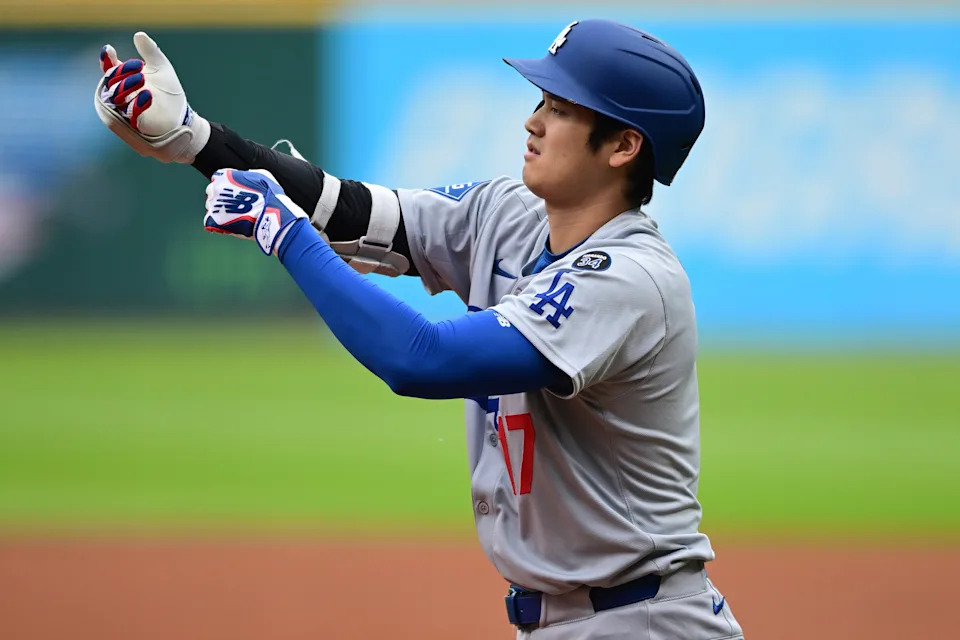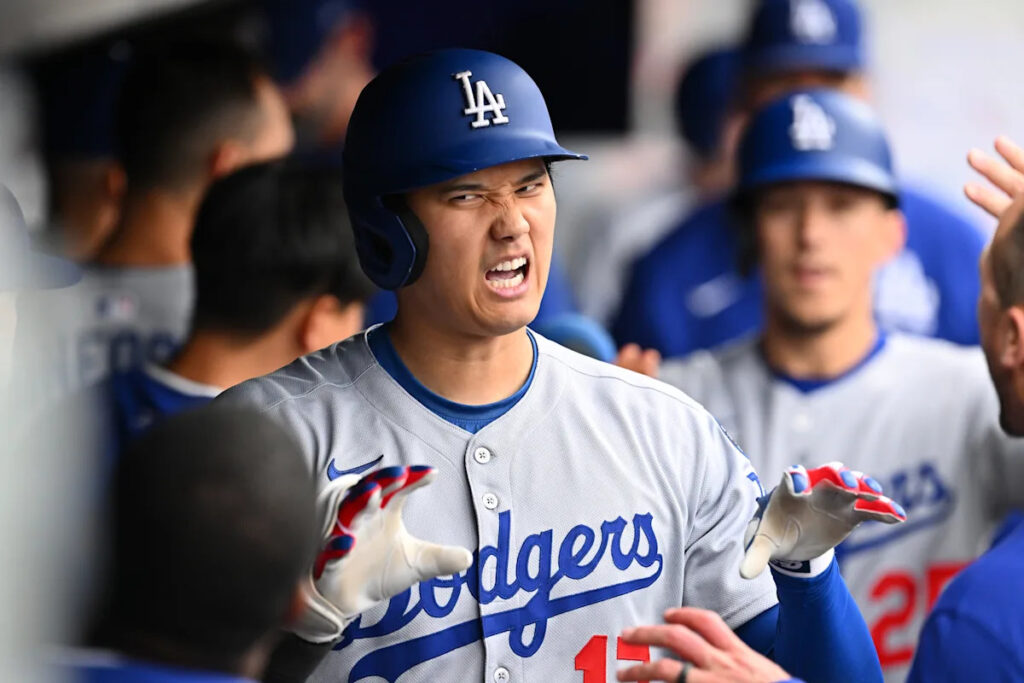CLEVELAND — For the third night in a row, Shohei Ohtani held his right arm aloft.
After clobbering a freakish opposite-field blast through a swarm of Lake Erie midges on Tuesday night against the Cleveland Guardians, the three-time MVP began his trot in a 9-5 victory for the Los Angeles Dodgers. It was the third consecutive game in which Ohtani had gone deep. He now leads baseball with 20 home runs.
As he rounded first, Ohtani lifted his arm and pointed toward the Dodgers bullpen, a gesture he makes after every homer. Around the league, that’s become a common salute of camaraderie and appreciation for a slugger to make. In Ohtani’s case, it also symbolizes something more.
That’s because his arm isn’t the same as other hitters. Each time Ohtani raises his surgically repaired, immeasurably valuable elbow, the Dodgers superstar is simultaneously offering an inadvertent reminder that the other side of his baseball life remains on ice.
Ohtani has not pitched in an MLB game since Aug. 23, 2023. Twenty seven days later, he underwent his second career reconstructive elbow surgery. He sat out the entire 2024 season as a pitcher — and still won MVP as a DH, becoming the first player ever to hit 50 homers and steal 50 bases in the same year. But heading into the 2025 season, anticipation grew about when Ohtani would resume his status as the game’s only two-way player.
On Sunday, he reached an important checkpoint in his comeback when he faced live hitters in New York. Ohtani threw 22 pitches, showcasing his entire arsenal. Later that evening, he smashed a home run to lead off the game. He has since gone deep twice more.
If everything goes to plan, Ohtani will face live hitters again over the weekend, most likely on Sunday afternoon before that night’s game against the Yankees.
Shohei Ohtani shows off that golden arm during warmups in the outfield on Tuesday in Cleveland. (Photo by Grace Hoppel/MLB Photos via Getty Images)
(Grace Hoppel via Getty Images)
“It’s certainly been tempered early,” Dodgers manager Dave Roberts said, “but now, when you start to ramp up facing hitters and doing back-to-backs and upping the innings, that takes a lot more mindful bandwidth and also physical exertion. So that’s gonna be interesting to see how he handles all this.”
Throughout the process, both Ohtani and the Dodgers have been insistent that the superstar’s return-to-mound timeline will be dictated by how Ohtani’s body feels. Given the strain accumulated by his nightly exploits as one of the planet’s best hitters, Ohtani’s pitching rehab is, like everything else about him, completely unique.
For example, when last Friday’s rain-delayed Mets/Dodgers game lasted until 1 a.m., Ohtani himself postponed the live pitching session that was originally scheduled for Saturday afternoon. He threw — against hitters for the first time since surgery — on Sunday instead.
It’s a sound, simple strategy. Ask the player how they’re feeling, adjust as necessary.
There’s only one problem with that inexact science: it’s an inexact science.
Ohtani is many things to the Dodgers. A DH, a leadoff hitter and, one day, a pitcher again. He is also a north star, a trajectory-altering colossus. The cornerstone of the operation. He is also a cash cow, an irreplaceable asset, and an expensive one at that. Even though the deferrals on Ohtani’s deal push its actual, inflation-adjusted total from the $700 million price tag closer to $460 million, according to MLB.com’s Mark Feinsand, it still represents a massive investment. But his value to the franchise, over the 10 years of his contract, is almost certain to stretch far beyond that figure. A recent estimate from the L.A. Times pegged Ohtani’s total influence on team revenue at $100 million a year. It could, given the scale of his superstardom, be even larger.
And so, it would be foolish, irresponsible even, for the Dodgers to handle the health and well-being of its most important person based entirely on “feeling.” Pitching coach Mark Prior, when talking to the media Sunday after the practice outing, downplayed the objective measurements the club is using to assess Ohtani’s rehab process.
“I mean, there is some data we have, but some, a lot of it is just how he’s feeling, he understands his body,” Dodgers pitching coach Mark Prior said.
That feels like a significant understatement, given how thorough, cutting edge and analytically inclined this organization is. And so, it’s a near certainty that the Dodgers are collecting some type of biometric data from Ohtani in order to monitor his workload and guide his comeback. That, in and of itself, is not unique in today’s game. Teams use wearable technology, like Driveline Baseball’s PULSE device, to track pitcher health. Many players around baseball wear fitness-tracking devices like Whoop or Oura Ring.
Ohtani himself has been seen wearing a Whoop on multiple occasions and praised the tech for helping him establish better sleep habits in a January 2022 GQ video titled “10 Things Shohei Ohtani Can’t Live Without.” Five of the 10 items referenced in the video are related to either sleep or recovery.
Reportedly, Ohtani adopted a more considered sleep regimen at some point during the 2020-2021 offseason. That change, according to people around the sport, played a non-negligible role in helping Ohtani unlock a new level of performance that he has sustained in the years since.
Unsurprisingly, objective information matters to the world’s best player.

What’s up Shohei Ohtani’s sleeve? Power, as he leads MLB with 20 homers this season. (AP Photo/David Dermer)
(ASSOCIATED PRESS)
Ohtani has worn the same striking jet black compression sleeve over his right arm in every single game he’s played as a Dodger. The device, made by a company named CW-X, is outfitted with various knobs and straps. It seems to include an integrated component further down his arm, just above his wrist that creates a noticeable outline underneath the uniform.
Interestingly, Ohtani did not wear the sleeve while pitching Sunday, though some sort of device was visible underneath his blue long-sleeve shirt.
CW-X does not sell arm sleeves or any upper body wear (besides sports bras) to the public. But a customer service representative for CW-X told Yahoo Sports that the sleeve Ohtani has been wearing was custom made for him by the company’s design team in Japan.
It is not shocking that the game’s most unique player, attempting a singular comeback, would request and require a bespoke piece of equipment.
And considering the stakes, the Dodgers are handling Ohtani’s road back to the mound with great care.
In other words, holding his arm aloft.
Read the full article here

